Download CBSE Class 11 Chemistry Hydrocarbon Notes Set D in PDF format. All Revision notes for Class 11 Chemistry have been designed as per the latest syllabus and updated chapters given in your textbook for Chemistry in Class 11. Our teachers have designed these concept notes for the benefit of Class 11 students. You should use these chapter wise notes for revision on daily basis. These study notes can also be used for learning each chapter and its important and difficult topics or revision just before your exams to help you get better scores in upcoming examinations, You can also use Printable notes for Class 11 Chemistry for faster revision of difficult topics and get higher rank. After reading these notes also refer to MCQ questions for Class 11 Chemistry given on studiestoday
Revision Notes for Class 11 Chemistry Chapter 9 Hydrocarbons
Class 11 Chemistry students should refer to the following concepts and notes for Chapter 9 Hydrocarbons in Class 11. These exam notes for Class 11 Chemistry will be very useful for upcoming class tests and examinations and help you to score good marks
Chapter 9 Hydrocarbons Notes Class 11 Chemistry
- Hydrocarbons are composed of Carbon and hydrogen.
- The important fuels like Petrol, kerosene, coal gas, CNG, LPG etc. are all hydrocarbons or their mixture.
Sources:
Petroleum and natural gas are the major sources of aliphatic hydrocarbon while coal is an important source of aromatic hydrocarbons. The oil trapped inside the rocks is known as petroleum. PETRA – ROCK, OLEUM – OIL. The oil in the petroleum field is covered with a gaseous mixture known as natural gas. The main constituents of the natural gas are methane, ethane, propane and butane.
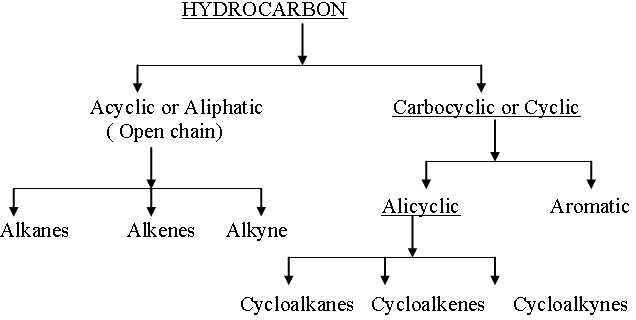
Classification Of Hydrocarbons:
Alkanes:-
- Paraffins
- General formula CnH2n+2
- sp3 hybridisation
- C–C bond length 1.15 4 A0
- Chemically unreactive
- Show chain, position and optical isomerism.
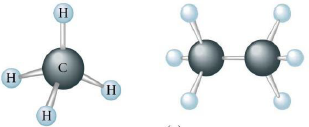
- Heptane has 9 isomer, Octane 18 and Decane 75.
Nomenclature:
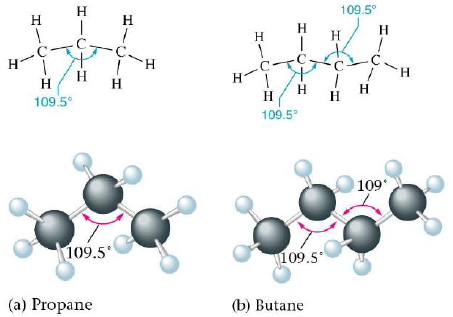
Preparation:-
1. Wurtz reaction:-
![]()
- Follow mainly free radical mechanism
- Useful in preparing an alkane containing even number of carbon atoms
- Stepping up reaction
Frankland reaction
RX+Zn+Rx → R–R+ZnX2
2. From Grignard reagent (RMgX)
RMgX + HOH → RH + Mg(OH)X
RMgX + R’OH → RH + Mg(OR’)X
RMgX + R’NH2 → RH + Mg(NHR’)X
3. From unsaturated hydrocarbons:-
Sabatier-Senderens reduction

4. From carboxylic acids-
Decarboxylation.-
Kolbe’s electrolytic method-
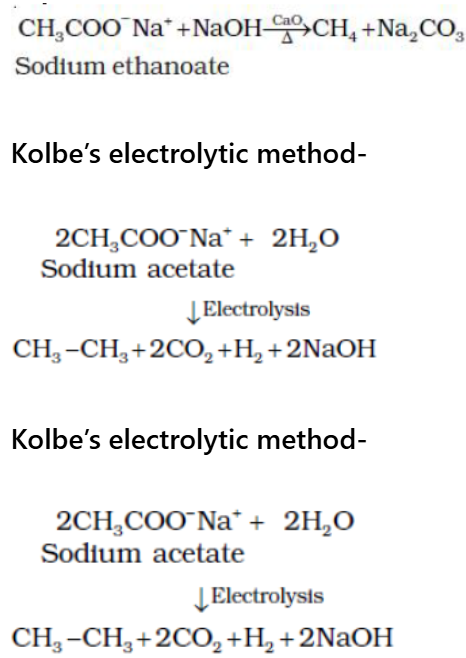
Physical Properties:-
(1) Nature:- Non-Polar due to covalent nature of C—C bond and C—H bond. C— C bond enrgy = 83 kj/mole and C—H bond energy = 99 kj/mole.
C1—C4 = gases, C5—C17 = colour less odour less liquid and > C17 = Solid.
(2) Solubility:- Like dissolve like Viz, Polar compounds dissolve in polar solvent and Non-Polar compound dissolve in
non polar solvent.
(3) Boiling point:- Low boiling point due to non polar in nature.
The molecules are held together only by weak Van der Waalls’ forces. Since we known that the magnitude of Van der Waalls’ forces is directly proportional to the molecular size. Therefore, the boiling point increases with increase the molecular size i.e. with increase in number of carbon atoms. Noted:- the boiling points of the branched chain Alkanes are less than the straight chain isomers.
This is due to the fact that branching of the chain makes the molecule more compact and thereby decreases the surface aria and consequently, the magnitudes of Van der Waalls’ forces also decrease.

regular variation with increase in molecular size. The Alkanes with even number of carbon atoms having higher melting point as compared to those Alkanes having immediately next lower and immediately next higher odd number of carbon atoms.
Chemical properties
1. Combustion:- CH4 2O2 → CO2 2H2O
ΔH = – 217.0 K cal/mole
2. Oxidation:-
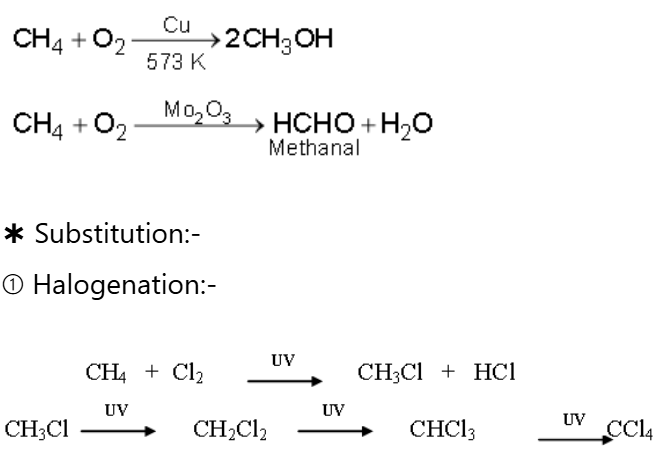
Noted:- Iodination is a reversible reaction. So it is carried out by heating alkane in the presence of some oxidizing agent like iodic acid (HIO3) or nitric acid (HNO3) or mercuric oxide (HgO) which oxidizes HI formed during the reaction.
![]()
5HI + HIO3 → 3H2O + 3I2
2HI + 2HNO3 → 2H2O + I2 + 2NO2
Noted:- Fluorination of alkane takes place explosively resulting even in the rupture of C— C bond in higher alkanes.
Features of Halogenations:-
(i) The reactivity of Halogens:- F2 > Cl2 > Br2 > I2.
(ii) The rate of replacement of Hydrogens of alkanes is:
3° > 2° > 1°
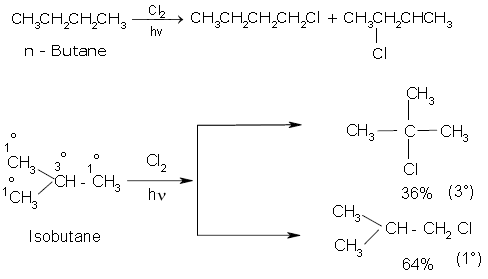
Mechanism:- halogenations reaction take place by free radical mechanism. The reaction proceeds in the following steps:
Initiation
(i) Chain initiation step:-
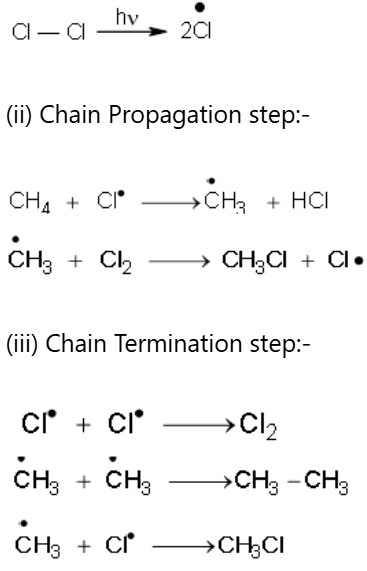
Nitration:-
- The reaction takes places by free radicals mechanism at high temp (4500C).
- At high temp C—C bond is also broken so that mixture of nitroalkanes is obtained.
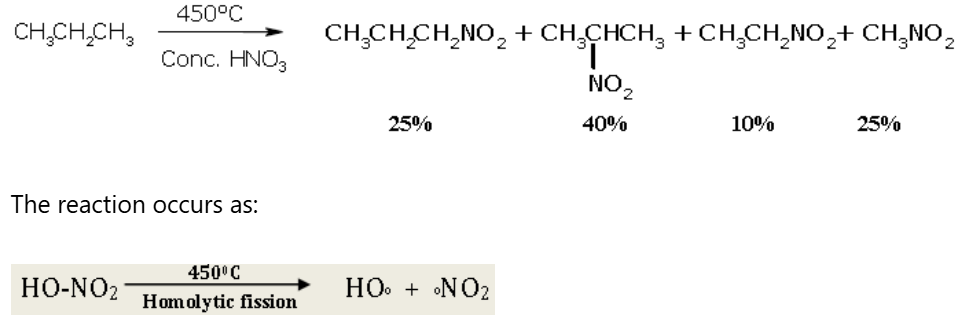
RH + 0OH → Ro + HOH
Ro + oNO2 → RNO2
Sulphonation:- replacement of hydrogen atom of alkane by –SO3H group
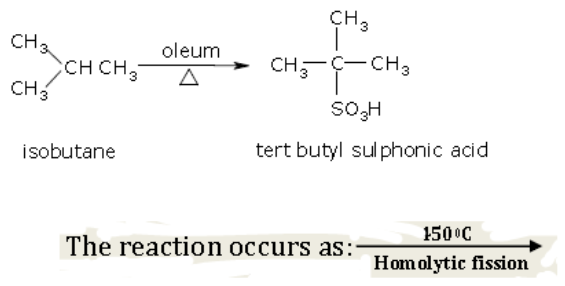
HO-SO3 → HOo + oSO3H
RH + 0OH → Ro + HOH
Ro + oSO2H → RSO2H
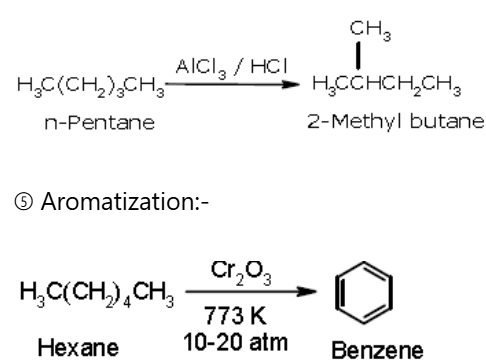
Aromatization:-
This method is also called dehydrogenation or hydroforming Similarly, heptane gives toluene, n-Octane give o-xylene and 2, methyl heptane give m-xylene.
6. Thermal decomposition or Pyrolysis or cracking or Fragmentation: – when higher alkanes are heated at high temp (about 700-800k) in the presence of alumina or silica catalysts, the alkanes break down to lower alkanes and alkenes.
CH3-CH2-CH3 → CH3-CH-CH2 + CH3-CH3 + C2H4 + CH4
7. Action of steam:- catalyst: nickel, alumina Al2O3

This reaction is used for the industrial preparation of hydrogen from natural gas.
8. Isomerisation:-
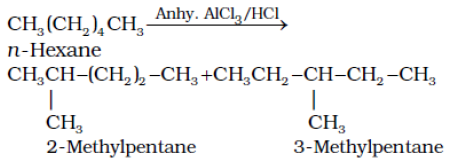
Conformational Isomerism:
The different molecular arrangements arising as a result of rotation around carbon carbon single bonds are called conformational isomers or rotational isomers and the phenomenon is called conformational isomerism.
Numerous possible arrangements of ethane are possible. Two extreme conformations are known. These are eclipsed conformation and staggered conformation.
Sawhorse Representation
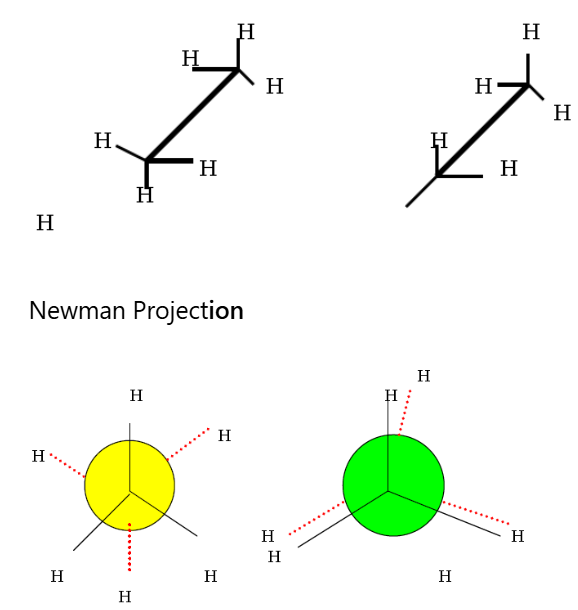
STAGGERED → SKEW ← ECLIPSED
Alkenes
- Unsaturated hydrocarbon which have double bond.
- General molecular formula CnH2n
- C–C bond hybridization 1.34 A0
- sp2 hybridization
- When we treated Alkene with chlorine, oily products are obtained. So Alkenes are also known as Olefins. (Greek olefiant meaning oil forming).
- Show chain, positional and geometrical isomerism
Structure of double bond:-
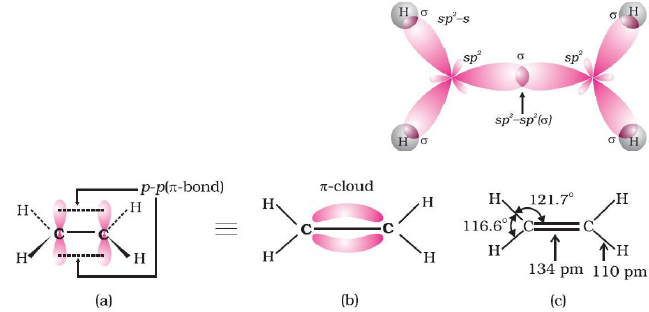
Preparation:-
1. From Alkynes:- Alkynes on partial reduction with Partially deactivated palladised charcoal known as Lindlar’s catalyst give alkynes.
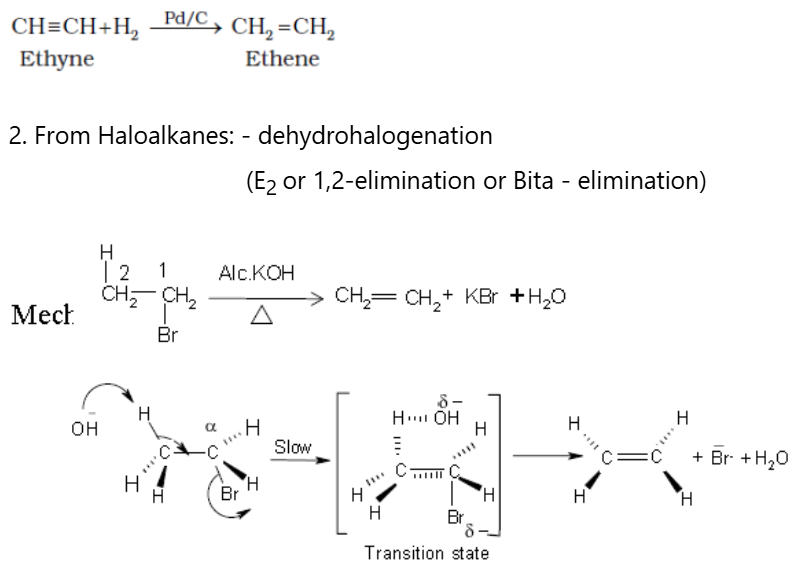
2. From Haloalkanes: – dehydrohalogenation
(E2 or 1,2-elimination or Bita – elimination)
- predominant formation of a substituted alkene is formed according to Saytzeff’s rule
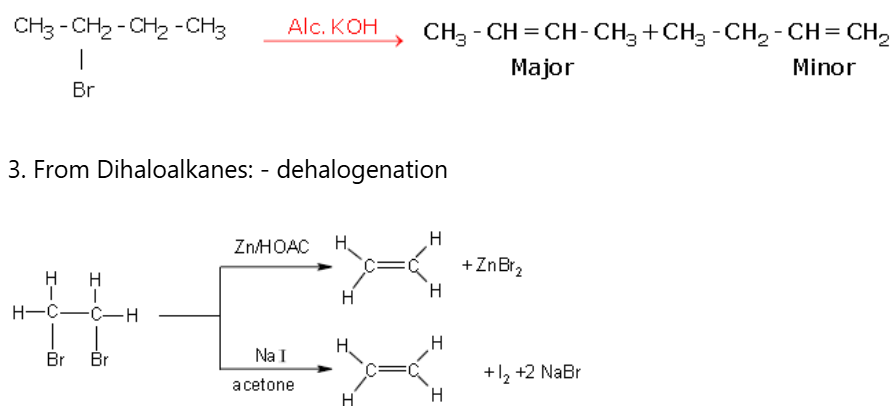
4. From Alcohols:- Dehydration
(E1 – elimination)

Chemical Properties:-
Addition Reaction:- Alkene show electrophilic addition reaction.
1. Addition of Hydrogen:-
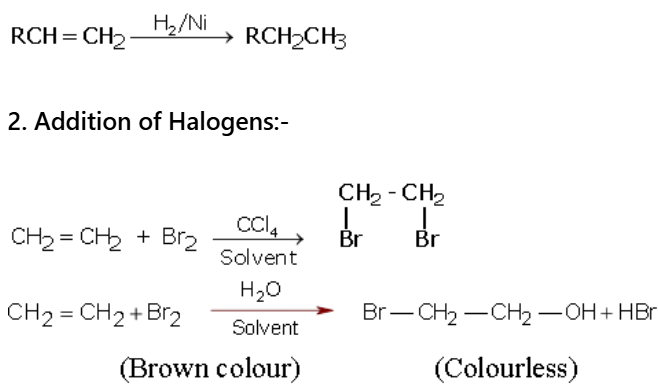
2. Addition of Halogens:-
3. Addition of hydrogen halides-
Addition reaction of HBr to symmetrical alkenes
Ch2 = CH2 + H – Br → CH3 – CH2 – Br
Addition reaction of HBr to unsymmetrical alkenes takes place according to Markovnikov Rule
Markownikov rule:- negative part of the addendum (adding molecule) gets attached to that carbon atom which possesses lesser number of hydrogen atoms. e g
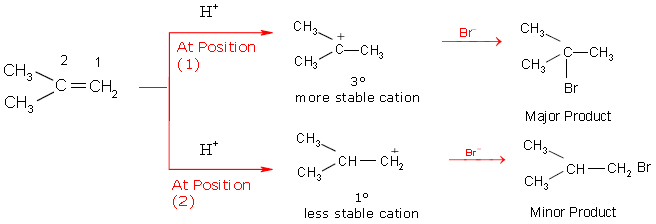
Peroxide effect or Kharasch (Anti Markownikoff’s addition):- In 1933 Kharasch and Mayo observed that when HBr is added to an unsymmetrical double bond in the presence of organic peroxide, the reaction take places opposite to the Markovnikov rule.
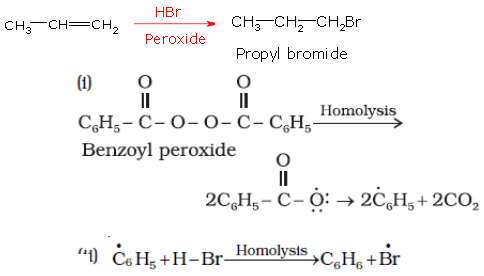
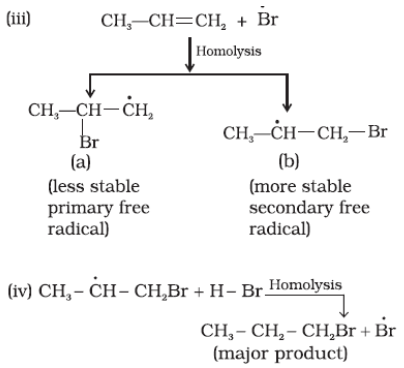
Noted:- peroxide effect is applicable only to HBr and not to HF, HCl and HI.
Addition of HF, HCl and HI takes place according to Markovnikov’s rule even in the presence of peroxide.
4. Addition of water (Hydration):- Acid catalyzed addition of water

2. Oxidation:-
Combustion:- CO2 + H2O
Hydroboration–oxidation:- Alkanes react with diborane to form trialkyl boranes
which on oxidation with alkaline H2O2 give alcohols

Oxymercuration–demercuration:-
Oxidation with potassium permanganate:-
2KMnO4 + H2O → 2KOH + 2MnO2 + 3 [O]

- This reaction is also called Hydroxylation
- Cis product I.e. cis-diol is obtained.
Noted:- The alkaline potassium permanganate solution is known as Baeyer’s reagent. It has bright pink colour. It oxidizes alkenes to glycols which is colour less. This reaction is used as a test for the presence of double bond in a molecule. This is also known as Baeyer test.
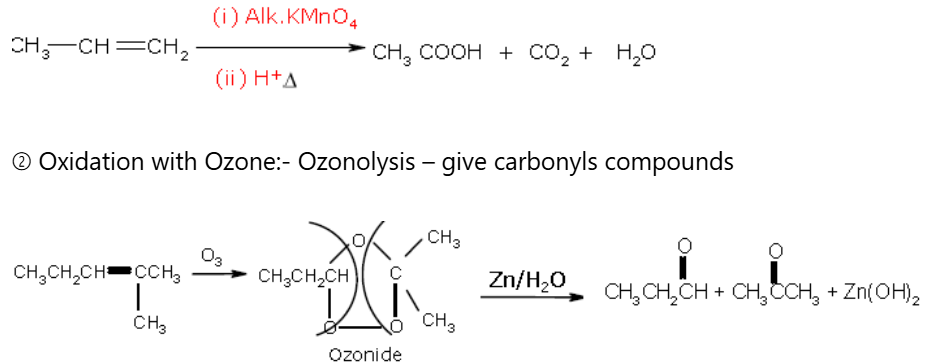
Noted:- Bromine water test and Baeyer’s test are used to detect the presence of double bond while ozonolysis is used to detect the position of double bond.
Alkynes
- Unsaturated hydrocarbon which have triple bond.
- General molecular formula CnH2n–2
- sp hybridization
- Shows chain, positional and functional isomerism
Preparation:-
From vicinal dihalides: – dehalogenation

By the action of water on calcium carbide:-
CaC2 + H2O → HC = CH + Ca(OH)2
- Chemical Properties:-
1. Addition Reaction:- Alkyne show electrophilic addition reaction.
Addition of Hydrogen:- Hydrogenation.

Noted:- It may be noted that the hydrogenation can be controlled at the alkene stage only. This is possible by using a Lindlar’s catalysts or sodium in liquid NH3 at 200k temp..
Noted:- It may be again noted that the catalytic reduction of alkynes in the presence of Lindlar’s catalyst gives cis-alkenes while in the presence of sodium in liquid NH3 (Birch reduction) gives trans-alkenes.
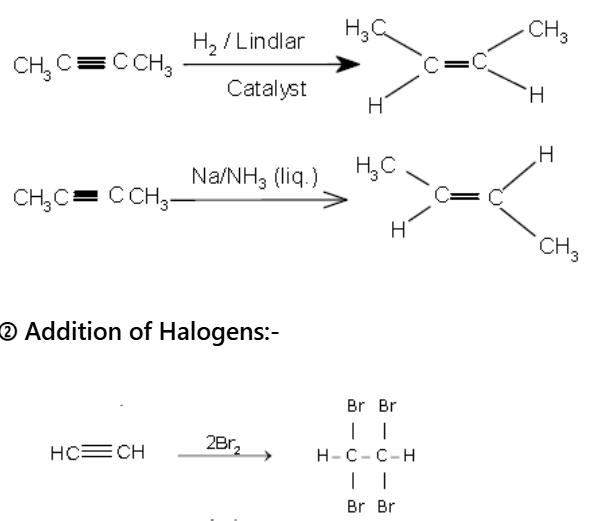
Addition of Halogens:-
Addition of hydrogen halides:-
HC ☰ CH + 2HBr → CH3CH Br2
Addition of water (Hydration):- Acid catalyzed addition of water
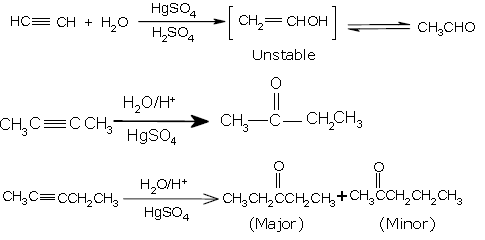
5. Polymerisationa.
a. Linear polymerisation: of ethyne gives polyacetylene or polyethyne which is a high molecular weight polyene containing repeating units of (CH = CH – CH = CH ) and can be represented as —(CH = CH – CH = CH)n —
b. Cyclic polymerization- results in the formation of aromatic compound.
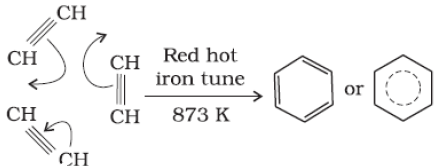
Acidity of Alkynes- Terminal alkynes are acidic in nature.
HC ☰ CH + Na → HC ☰ C Na+ + 1/2H2
Monosodium ethynide
CH3 – C ☰ C – H + Na+ NH-2
↓
CH3 – C ☰ C- Na+ + NH3
Sodium propynide
Alkanes, alkenes and alkynes follow the following trend in their acidic behaviour :
i) HC ☰ CH > H2C = CH2 > CH3 – CH3
ii) HC ☰ CH > CH3 – C ☰ CH >> CH3 – C ☰ C- CH3
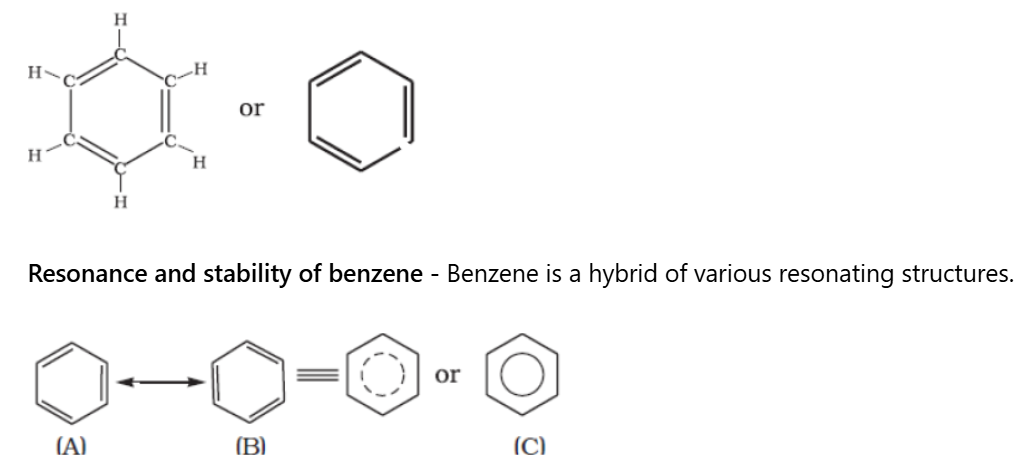
The orbital overlapping picture benzene – All the six carbon atoms in benzene are sp2 hybridized and these hybrid orbitals form sigma bonds.
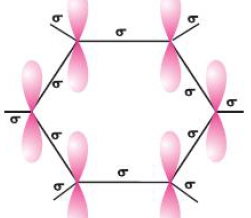
The unhybridised p orbital of carbon atoms are close enough to form a π bond by lateral overlap.

The six π electrons are thus delocalised and can move freely about the six carbon nuclei. The delocalised π electron cloud is attracted more strongly by the nuclei of the carbon atoms than the electron cloud localized between two carbon atoms.
Therefore, presence of delocalised π electrons in benzene makes it more stable .
Aromaticity:- The compounds that follow the following features are to be considered aromatic.
(i) Planarity
(ii) Complete delocalisation of the π electrons in the ring
(iii) Presence of (4n + 2) π electrons in the ring where n is an integer (n = 0, 1,
2, . . .). This is often referred to as Hückel Rule.
Preparation of Benzene:
(i) Cyclic polymerisation of ethyne:
(ii) Decarboxylation of aromatic acids:
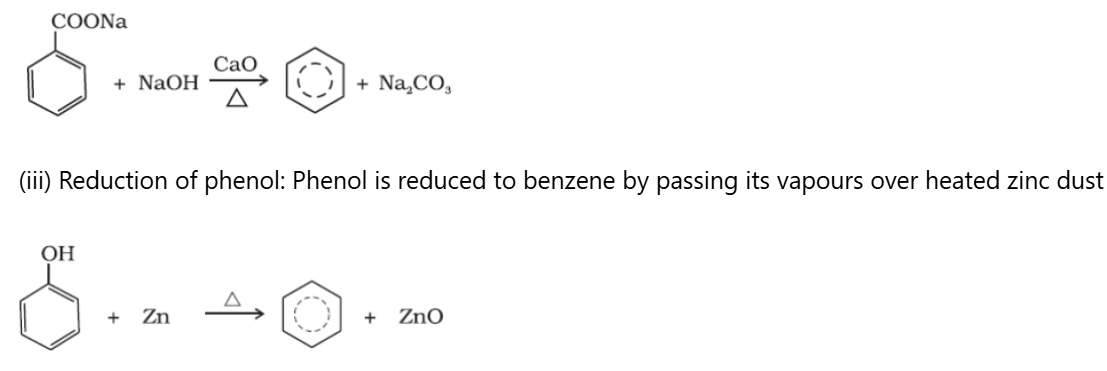
Physical properties:
1. Aromatic hydrocarbons are non- polar molecules and are usually colourless liquids or solids with a characteristic aroma.
2. Aromatic hydrocarbons are immiscible with water but are readily miscible with organic solvents.
3. They burn with sooty flame.
Chemical properties
Arenes are characterised by electrophilic substitution reactions proceed via the following three steps:
(a) Generation of the eletrophile
(b) Formation of carbocation intermediate
(c) Removal of proton from the carbocation intermediate
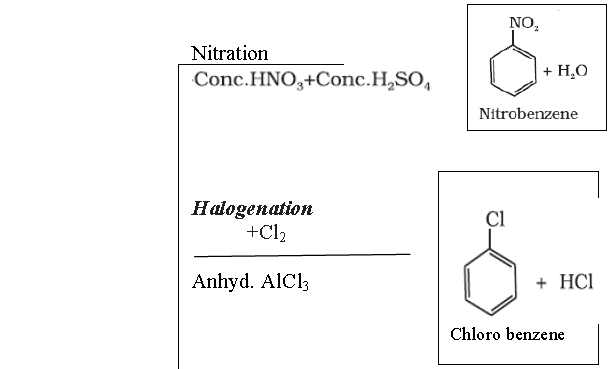
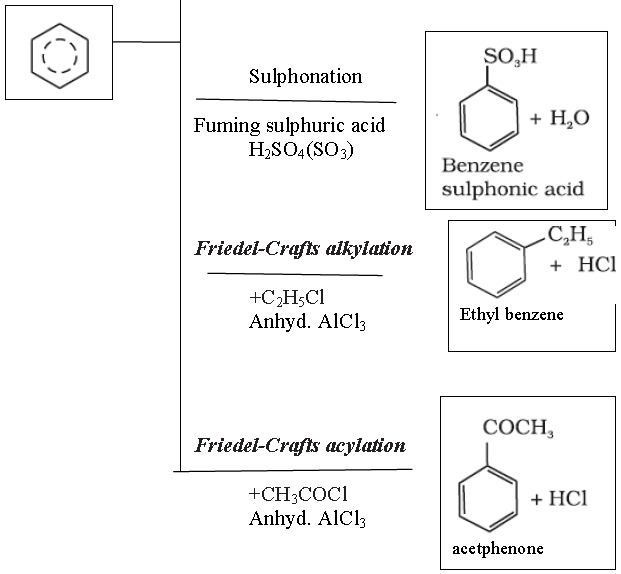
benzene ontreatment with excess of chlorine in the presence of anhydrous AlCl3 in dark yields hexachlorobenzene (C6Cl6)
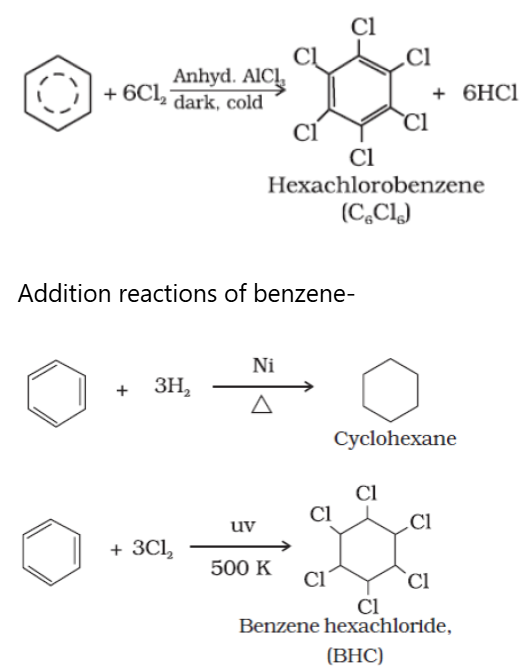
Directive influence of a functional group in monosubstituted benzene:-
1. Ortho and para directing groups and activating- –OH, –NH2, –NHR, – NHCOCH3, –OCH3, –CH3, –C2H5, etc.
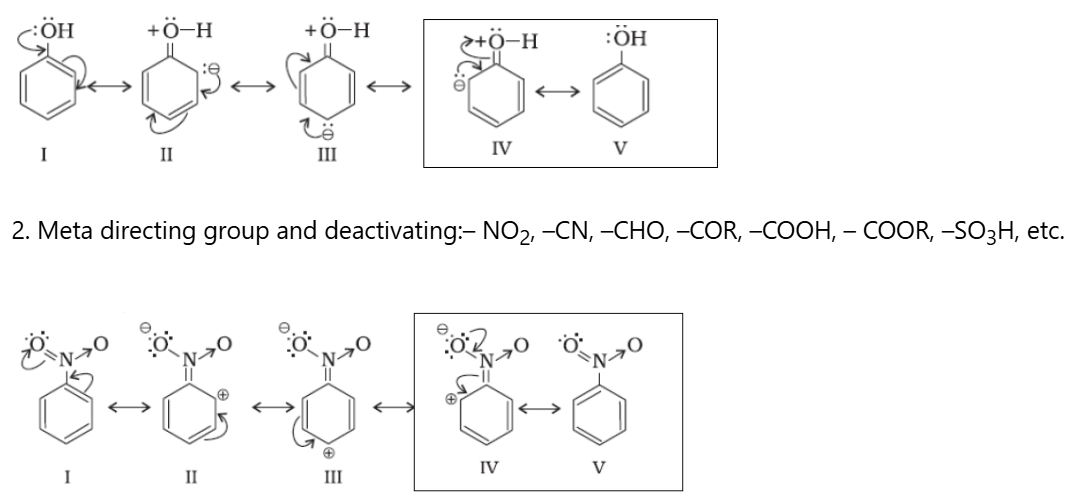
3. Ortho and para directing groups and deactivating- Halogens because of their strong – I effect, overall electron density on benzene ring decreases. However, due to resonance the electron density on o– and p– positions is greater than that at the m-position. Hence, they are also o– and p– directing groups
Carcinogenicity And Toxicity – Benzene and polynuclear hydrocarbons containing more than two benzene rings fused together are toxic and said to possess cancer producing (carcinogenic) property.
Important Questions Hydrocarbons
Question. What are hydrocarbons?
Answer: Compounds of hydrogen and carbon.
Question. What is the general formula of alkanes?
Answer: CnH2n+2
Question. Write the general formula of alkenes.
Answer: CnH2n
Question. What is the general formula of alkynes?
Answer: CnH2n-2
Question. Give the IUPAC name of lowest molecular weight alkane that contains a quaternary carbon.
Answer: 2,2dimethylpropane.
Question. Arrange the following in the increasing order of C-C bond length- C2H6 C2H4 C2H2
Answer: C2H2 < C2H4 < C2H6
Question. Out of ethylene and acetylene which is more acidic and why?
Answer: Acetylene, due to greater electonegativity of the sp hybrid carbon.
Question. Name two reagents which can be used to distinguish between ethene and ethyne.
Answer: Tollen’s reagent and ammonical CuCl solution.
Question. Arrange the following in order of decreasing reactivity towards alkanes.
HCl, HBr, HI, HF
Answer: HI> HBr> HCl >HF
Question. How will you detect the presence of unsaturation in an organic compound?
Answer: Generally Unsaturated organic compound decolourise Bayer’s reagent and Bromine water.
Question. What is Grignard reagent?
Answer: Alkyl magnesium halides
Question. Write the IUPAC names of the following

Answer: a .Pent-en-3-yne b. 2-methylphenol
Question. Write chemical equations for combustion reaction of (i) Butane (ii) Toluene
Answer:
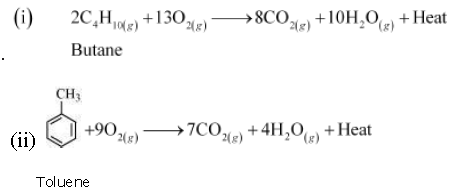
Question. What are the necessary conditions for any system to be aromatic?
Answer: A compound is said to be aromatic if it satisfies the following three conditions: (i) It should have a planar structure.
(ii) The π–electrons of the compound are completely delocalized in the ring.
(iii)The total number of π–electrons present in the ring should be equal to (4n + 2), where n = 0, 1, 2 … etc. This is known as Huckel’s rule.
Question. What effect does branching of an alkane chain has on its boiling point?
Answer: As branching increases, the surface area of the molecule decreases which results in a small area of contact. As a result, the Van der Waals force also decreases which can be overcome at a relatively lower temperature. Hence, the boiling point of an alkane chain decreases with an increase in branching.
Question. How would you convert the following compounds into benzene?
(i) Ethyne (ii) Ethene

Answer: (i) Benzene from Ethyne:
(ii) Benzene from Ethene:
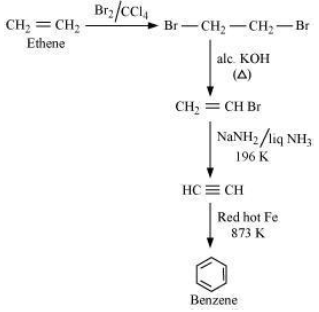
Question. Suggest the name of Lewis acids other than anhydrous aluminium chloride which can be used during ethylation of benzene.
Answer: anhydrous FeCl3, SnCl4, BF3 etc.
Question. Write the name of all the possible isomers of C2H2Cl2 and indicate which of them is non-polar.
Answer: (i) cis-1,2-dichloroethene (ii) trans-1,2-dichloroethene (iii) 1,1- dichloroethene. trans-1,2-dichloroethene is non-polar.
Question. Although benzene is highly unsaturated, it does not undergo addition reactions, why?
Answer:Because of extra stability due to delocalization of π-electrons.
Question. What are alkanes? Why are they called paraffins?
Answer: Those hydrocarbons which contain single bond between carbon- carbon are called alkanes. They are called paraffins because they are very less reactive (Latin- Parum= little, affins = affinity)
Question. How can ethene be prepared from (i) ethanol (ii) ethyl bromide?
Answer: (i) Ethene from ethanol- by acidic dehydration of alcohols

(ii) Ethene from ethyl bromide – by dehydrohalogenation of ethyl bromide
CH3CH2Br + KOH (alc) → H2C = CH2 + KBr + H2O
Question. What is Wurtz reaction? How can it be used to prepare butane?
Answer: When alkyl halides is treated with metallic Na in presence of dry ether, alkanes are formed. This reaction is called Wurtz reaction. Butane is prepared by the reaction of bromoethane with metallic Na in presence of dry ether
![]()
Question. An alkene ‘A’ contains three C – C, eight C – H σ bonds and one C – C π bond. ‘A’ on ozonolysis gives two moles of an aldehyde of molar mass 44 u. Deduce IUPAC name of ‘A’.
Answer: The formation of two moles of an aldehyde indicates the presence of identical structural units on both sides of the double bond containing carbon atoms. Hence, the structure of ‘A’ can be represented as:
XC = CX
There are eight C–H σ bonds. Hence, there are 8 hydrogen atoms in ‘A’. Also, there are three C–C bonds. Hence, there are four carbon atoms present in the structure of ‘A’. Combining the inferences, the structure of ‘A’ can be represented as:
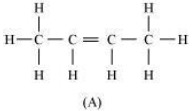
the IUPAC name of ‘A’ is But – 2- ene.
Ozonolysis of ‘A’ takes place as:
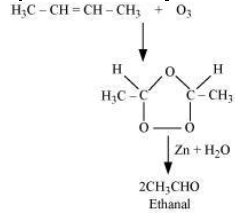
The final product is ethanal with molecular mass
= [(2 X 12) + (4 X 1) + (1 X 16)] = 44u
Question. In the alkane H3C – CH2 – C(CH3)2 – CH2 – CH(CH3)2, identify 1°,2°,3° carbon atoms and give the number of H atoms bonded to each one of these.
Answer:

The given structure has five 1° carbon atoms and fifteen hydrogen atoms attached to it.
The given structure has two 2° carbon atoms and four hydrogen atoms attached to it.
The given structure has one 3° carbon atom and only one hydrogen atom is attached to it
Question. Addition of HBr to propene yields 2-bromopropane, while in the presence of benzoyl peroxide, the same reaction yields 1-bromopropane. Explain and give mechanism
Answer: Addition of HBr to propene is an example of an electrophilic substitution reaction. Hydrogen bromide provides an electrophile, H+. This electrophile attacks the double bond to form 1° and 2° carbocations as shown:
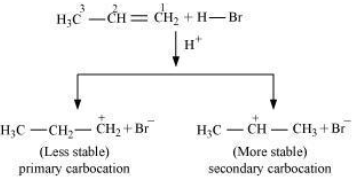
Secondary carbocations are more stable than primary carbocations. Hence, the former predominates since it will form at a faster rate. Thus, in the next step, Br – attacks the carbocation to form 2 – bromopropane as the major product.

This reaction follows Markovnikov’s rule In the presence of benzoyl peroxide, an addition reaction takes place anti to
Markovnikov’s rule. The reaction follows a free radical chain mechanism as:

Secondary free radicals are more stable than primary radicals. Hence, the former predominates since it forms at a faster rate. Thus, 1 – bromopropane is obtained as the major product.

Question. How will you demonstrate that double bonds of benzene are somewhat different from that of olefins?
Answer: The double bonds of olefins decolourize bromine water and discharge the pink colour of Bayer’s reagent while those of benzene not
Question. How will you separate propene from propyne?
Answer: By passing the mixture through ammonical silver nitrate solution when propyne reacts while propene passes over.
Question. Write is the structure of the alkene which on reductive ozonolysis gives butanone and ethanol,
Answer: CH3CH2C(CH3)=CHCH3
| CBSE Class 11 Chemistry Basic Concepts Of Chemistry Notes Set A |
| CBSE Class 11 Chemistry Basic Concepts Of Chemistry Notes Set B |
CBSE Class 11 Chemistry Chapter 9 Hydrocarbons Notes
We hope you liked the above notes for topic Chapter 9 Hydrocarbons which has been designed as per the latest syllabus for Class 11 Chemistry released by CBSE. Students of Class 11 should download and practice the above notes for Class 11 Chemistry regularly. All revision notes have been designed for Chemistry by referring to the most important topics which the students should learn to get better marks in examinations. Our team of expert teachers have referred to the NCERT book for Class 11 Chemistry to design the Chemistry Class 11 notes. After reading the notes which have been developed as per the latest books also refer to the NCERT solutions for Class 11 Chemistry provided by our teachers. We have also provided a lot of MCQ questions for Class 11 Chemistry in the notes so that you can learn the concepts and also solve questions relating to the topics. We have also provided a lot of Worksheets for Class 11 Chemistry which you can use to further make yourself stronger in Chemistry.
You can download notes for Class 11 Chemistry Chapter 9 Hydrocarbons for latest academic session from StudiesToday.com
Yes, the notes issued for Class 11 Chemistry Chapter 9 Hydrocarbons have been made available here for latest CBSE session
There is no charge for the notes for CBSE Class 11 Chemistry Chapter 9 Hydrocarbons, you can download everything free of charge
www.studiestoday.com is the best website from which you can download latest notes for Chapter 9 Hydrocarbons Chemistry Class 11
Come to StudiesToday.com to get best quality topic wise notes for Class 11 Chemistry Chapter 9 Hydrocarbons

